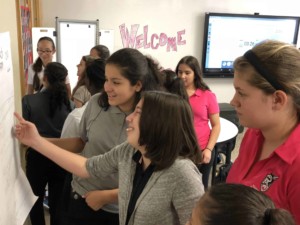A Brief Guide to Tech Training for Faculty
“A Brief Guide to Tech Training for Faculty” by Jennifer Funk was first seen on the Edcetera blog.

Educators deal with a reality that most tech users do not: responsibility to their students. And, students can be a tricky sort, at least according to reports claiming that some want more tech use in the classroom, while others say that they prefer traditional books and lectures.
Regardless, do we really need another report speculating whether or not technology is a game changer? Look around (as in, actually look up from the computer or mobile device you’re reading this on) and count the number of people using laptops, smartphones, iPads, Kindles and MP3 players.
Despite tech’s ubiquity, it’s one thing to teach yourself to use Skype, Twitter, or Hot Tech Tool #1,396, but another thing to rethink your curriculum, choose an appropriate technology, teach yourself to use it, revamp your curriculum, roll it out to critical learners, and tweak and re-tweak ad nauseam.
The irony of technology — at least educational technology — is that its integration is hard, no matter how many Apple commercials suggest otherwise.
But, hard does not mean inaccessible.
In fact — “The tools that enable us to experiment with new modes of education are mostly free, and they can be implemented in many diverse bits and pieces without the need for large-scale, top-down planning or intervention,” says Michael Wesch, associate professor at Kansas State University and educational technology advocate, in this 2011 Campus Technology piece.
A Starting Point: Inquiry-Based Discussion
When experimenting with these “new modes of education”, start with questions about pedagogy and learning objectives.
At Penn State, ITS Training Services encourages faculty to attend discussion-based training sessions rather than hands-on sessions when they’re first considering using technology in their classes. A trainer serves as a facilitator while participants brainstorm ideas for how technology can support their teaching.
“Regardless of [faculty members’] existing experience using technology in the classroom, we encourage all faculty to really think about pedagogy and how technology can enhance it,” says Chris Lucas, ITS Training Director.
If your university doesn’t offer similar sessions, coordinate your own. Reach out to colleagues — tech advanced and averse — and meet to explore the possibilities that exist at the intersection of your discipline(s) and technology. Lucas says a particularly useful reference is Educause’s “7 Things You Should Know About” series, short papers highlighting emerging technologies as they relate to teaching and learning.
Another useful reference is Ed Tech Teacher’s ‘Great Tech Tools’ offering comparisons of various tech tools according to learning goal.
Resources for DIY Tech Training
As with most inquiry-based discussions, you’re likely to end up with more questions than answers, but make sure at least one question is answered: what tech tool makes the most sense to integrate into your curriculum given your discipline, your students’ characteristics, the campus-wide technology infrastructure, your course load, and your research responsibilities?
Once you determine the answer, it’s time for some role reversal. Be the student — not the one who slumps in his seat in the back row, near the aisle, texting in the pocket of his hoodie, but the inquisitive one who arrives early, sits in the front row, breaks pencils taking notes, and pesters you with questions after class.
If you chose the right tool, you shouldn’t have a hard time becoming an impassioned learner. The more comfortable you become with the tool, the more you’ll recognize its benefits. Research suggests that among faculty who’ve used technology to support their teaching, enthusiasm is high for future use.
There are lots of places to find the training you need.
First, your university. Penn State has responded to challenges like training a large, dispersed campus community who prefer to learn in 1:1 settings, by recording Adobe Connect training sessions, employing Technology Learning Assistants (students who provide 1:1 support upon request), and developing a vendor relationship with Lynda.com. Your university likely offers similar programs.
Lucas says faculty already comfortable using technology in the classroom get their training online. Online resources include Teacher Training Videos, Ed Tech Teacher webinars, YouTube,Lynda.com and vendor support and/or community sites.
Let’s say, for example, you decide to survey your incoming freshmen on the types of reading they do. A great tool for that is Survey Monkey. A quick search at some of the above resources yields a couple pages of results on YouTube, a 55-minute free video on Lynda.com, a series of written tutorials on Survey Monkey’s website, and a 12-step video on Teacher Training Videos. Searches for most tech tools will have similar results.
What Students Really Want
As far as that responsibility to students goes — the one that makes technology adoption especially complicated, but also especially important — a recent CDW-G report sheds some light: they want it all. The most satisfied students, according to the report, were those whose instructors used all types of learning models, traditional and technological. So, the time to learn is now.
What on-campus and online training resources do you find most useful?




0 Comments
Leave a Comment
Your email address will not be published. All fields are required.